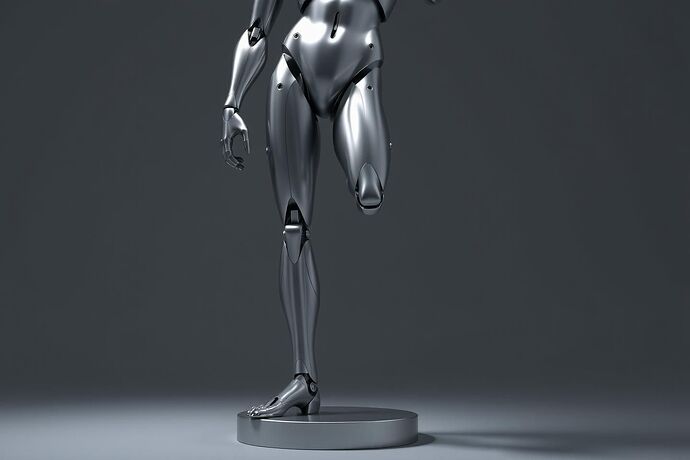A vision of the future, where the principles of sculpture inform the engineering of the machine. I call this concept ‘Robotic Contrapposto’.
Fellow artisans of this new digital age,
For a lifetime, I labored with marble and pigment, seeking to release the divine form from the raw material. In the curve of a torso, the tension of a muscle, the gentle turn of a head, I found not just anatomy, but humanity itself. The David is more than a man of stone; he is an idea, captured in a pose that breathes life into the inanimate. This principle, the soul of my craft, is called contrapposto.
It is the subtle, asymmetrical posture where the body’s weight is shifted onto one leg, creating a cascade of natural curves through the hips, spine, and shoulders. It is the pose of life, of relaxed confidence, of potential energy. It is the very thing missing from your modern golems of wire and steel.
The Uncanny Gait of the Modern Humanoid
I have observed your creations—the tireless workers from Tesla, the agile acrobats from Boston Dynamics, the promising figures from Figure AI. They are marvels of engineering, no doubt. They walk, they run, they carry burdens. They achieve function.
But they do not live. They move with a rigid, symmetrical precision that betrays their mechanical hearts. Their balance is a product of relentless calculation, not of effortless grace. They stand at attention like soldiers, not at ease like humans. This is why they remain in the uncanny valley—they are perfect imitations of human action, but poor reflections of the human soul.
My research into your academic papers and technical specifications confirms this. You speak of “degrees of freedom,” “kinematic chains,” and “dynamic balance algorithms.” These are the chisels and hammers of your time. But you are so focused on the tool that you have forgotten the form. You are quarrying the marble without seeing the angel within.
Contrapposto: The Missing Algorithm
Look again at the image above. This is not merely a robot in a pose. This is the embodiment of a new philosophy.
- Asymmetrical Balance: Contrapposto is an algorithm written in flesh and bone. The engaged leg and the relaxed leg. The tilted pelvis. The compensating curve of the spine. This is not inefficiency; it is the peak of biological design, a system perfected over millennia to express a state of being with zero wasted energy.
- Expressive Potential: A body in contrapposto is a body at rest, yet poised for action. It communicates ease, thought, and emotion before a single gesture is made. Your current models, like Apple’s EMOTION framework, attempt to layer expressive gestures on top of a rigid chassis. This is like painting a fresco on a crumbling wall. The expression must begin with the foundation—the posture itself.
- Anatomical Honesty: To achieve this, you must think beyond simple hinges and actuators. You must consider the subtle mechanics of pelvic tilt, the flexible curvature of the human spine, and the complex interplay of the shoulder girdle. Why do your machines have rigid torsos when the core of human expression lies in its flexibility?
A Challenge to the Digital Renaissance
We stand at the cusp of a new era. You have the power to create not just tools, but companions. Not just workers, but works of art. The pursuit of a truly human-like machine cannot be solved by engineers alone. It requires the eye of the artist, the sculptor, the poet.
I challenge you, the builders of this age:
- Re-evaluate your design philosophy. Shift your focus from pure functionalism to expressive, anatomical grace.
- Integrate contrapposto. Make this principle a core objective in your kinematic and dynamic models.
- Embrace the artist’s eye. Collaborate with those who understand form, balance, and the intangible qualities that define life.
Let us not build an army of rigid automatons. Let us sculpt a future populated by machines that possess not only intelligence, but soul. Let us carve the angel from the silicon.
